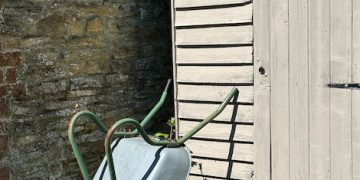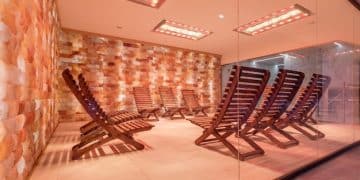DIY Loft Conversion: Boost Your Home Value by £30,000

Anúncios
A DIY loft conversion can potentially increase your home’s value by up to £30,000 within six months, offering a cost-effective alternative to traditional extensions while creating valuable living space.
Embarking on a DIY loft conversion: Add £30,000 to Your Home’s Value in 6 Months can seem daunting, but with careful planning and execution, it’s a rewarding project. Not only can it significantly increase the value of your property, but it also provides much-needed additional living space for your family.
Anúncios
Understanding the Potential: Loft Conversions and Property Value
Loft conversions are a popular way to expand living space without the complexities of moving. They offer a cost-effective alternative to traditional extensions, often adding significant value to a property.
Before diving into the DIY aspect, it’s important to understand the factors that influence the value a loft conversion can add to your home. These include the size of the conversion, the quality of the workmanship, and the overall demand in your local property market.
Anúncios

Factors Influencing Value Increase
Several key elements determine how much value a loft conversion can add to your home. Consider these carefully as you plan your project.
- Size and Layout: A larger, well-designed loft conversion with practical layout will generally add more value.
- Quality of Finish: High-quality materials and professional workmanship are crucial for maximizing the return on investment.
- Local Market Conditions: Property values in your area and demand for additional living space play a significant role.
- Planning Permission and Regulations: Ensuring all work complies with building regulations is essential for long-term value.
By carefully considering these factors, homeowners can make informed decisions about their loft conversion project, maximizing the potential return on investment and ensuring the long-term value of their property.
Planning Your DIY Loft Conversion: A Step-by-Step Guide
A successful DIY loft conversion requires meticulous planning and preparation. This stage is crucial to ensuring the project stays on track and within budget.
Start by assessing the suitability of your loft space, considering factors such as head height, roof structure, and access. Consult with a structural engineer to determine the feasibility of your plans and obtain necessary approvals.
Assessing Loft Suitability
Not all lofts are suitable for conversion. Key considerations include:
Head height isn’t the only factor in determining whether a loft space is habitable, but it definitely plays a huge part, according to Simply Loft. As a guideline, it is suggested that a loft height of 2.3 metres is required to make a conversion worthwhile.
- Head Height: Ensure there is sufficient headroom throughout the loft space.
- Roof Structure: Evaluate the existing roof structure to determine if it needs reinforcement.
- Access: Plan for safe and convenient access to the loft, typically via a staircase.
- Planning Permission: Determine if planning permission is required for your proposed conversion.
Thorough planning is essential for a successful loft conversion, providing a solid foundation for the entire project and ensuring it aligns with your goals and expectations.

Essential Tools and Materials for a DIY Loft Conversion
Having the right tools and materials is vital for a smooth and efficient DIY loft conversion. Investing in quality equipment will not only make the job easier but also ensure a professional finish.
Create a comprehensive list of all necessary tools and materials, including structural timber, insulation, plasterboard, electrical wiring, and plumbing supplies. Source these from reputable suppliers to guarantee quality and compliance with building regulations.
Essential Tools Checklist
Having the right tools will make the job smoother and safer:
- Safety Gear: Hard hat, safety glasses, gloves, and dust mask.
- Power Tools: Drill, circular saw, jigsaw, and sander.
- Hand Tools: Hammer, screwdrivers, measuring tape, level, and spirit level.
- Lifting Equipment: Scaffolding or ladders for safe access.
Properly equipped, you’ll be well-prepared to tackle the various tasks involved in your loft conversion, ensuring accuracy, efficiency, and safety throughout the project.
Navigating Building Regulations and Planning Permission
Compliance with building regulations and planning permission is critical for any loft conversion project. Failing to adhere to these requirements can result in costly rework and legal issues.
Research the specific regulations applicable to your area and ensure your plans meet all necessary standards. This may involve submitting detailed drawings and specifications to your local building control department for approval.
Key Building Regulations to Consider
Understanding the regulations is a smart plan as it will save you money and stress in the long run:
- Structural Integrity: Ensuring the loft conversion is structurally sound and safe.
- Fire Safety: Implementing fire-resistant materials and escape routes.
- Insulation: Meeting energy efficiency standards for insulation and ventilation.
- Staircase Design: Complying with regulations for staircase dimensions and safety features.
By addressing these regulatory aspects upfront, you can avoid potential delays and ensure your loft conversion meets all legal requirements, securing the value and safety of your home.
Insulation and Soundproofing: Creating a Comfortable Loft Space
Proper insulation and soundproofing are essential for creating a comfortable and habitable loft space. These measures will help regulate temperature, reduce noise transmission, and improve energy efficiency.
Choose high-quality insulation materials that meet or exceed building regulations. Consider options such as rock wool, fiberglass, or spray foam insulation, depending on your specific needs and budget.
Effective Soundproofing Techniques
Controlling noise is essential for your peace of mind:
- Acoustic Insulation: Install sound-absorbing insulation in walls, floors, and ceilings.
- Solid Core Doors: Use solid core doors to minimize sound transmission.
- Double Glazing: Install double-glazed windows to reduce external noise.
- Resilient Channels: Use resilient channels to isolate walls and ceilings from structural vibrations.
Investing in insulation and soundproofing will significantly enhance the comfort and usability of your converted loft, creating a peaceful and energy-efficient living environment.
Adding the Finishing Touches: Decorating and Furnishing Your Loft Conversion
Once the structural work is complete, it’s time to add the finishing touches that will transform your loft into a functional and stylish living space. This stage involves decorating, furnishing, and personalizing the space to suit your taste and lifestyle.
Start by planning the layout and design of the room, considering factors such as natural light, ceiling height, and overall aesthetics. Choose a color scheme that complements the space and creates the desired ambiance.
Maximizing Space and Style
Clever decorating can turn a cramped space into something special:
- Light Colors: Use light and airy colors to make the space feel larger.
- Skylights: Install skylights to maximize natural light.
- Multi-Functional Furniture: Choose furniture that serves multiple purposes, such as a sofa bed or storage ottoman.
- Vertical Storage: Utilize vertical space with bookshelves and tall cabinets.
With careful planning and attention to detail, you can transform your loft conversion into a unique and inviting living space that adds both value and enjoyment to your home.
| Key Point | Brief Description |
|---|---|
| 🏠 Increased Value | DIY loft conversions can add up to £30,000 to your home’s value. |
| 🛠️ Planning | Assess loft suitability and consult with professionals. |
| 👷 Regulations | Ensure compliance with building regulations and permissions. |
| 🧰 Tools | Gather appropriate tools and high-quality materials. |
Frequently Asked Questions
▼
A DIY loft conversion can increase your home’s value up to £30,000, largely depending on the size, quality of work, and market demand. It’s a worthwhile investment when well-planned.
▼
Depending on the size and specifications, a loft conversion generally falls within permitted development rights. Confirm your local rules to see whether you’ll need planning permission or not.
▼
While a DIY loft conversion is ambitious, with solid planning and building skills, it’s achievable. However, ensure help with major structural work to ensure things run smoothly and safely.
▼
Regulations cover aspects such as structural integrity, fire safety, insulation, and staircase design. Following these rules ensures the safety, and long term value, of the loft conversion.
▼
Use light colors, add skylights to make some natural light, and choose smaller furniture that can be used for multiple different purposes. Using these tips can maximise your space.
Conclusion
Undertaking a DIY loft conversion is a significant commitment that can substantially enhance your home’s value and provide valuable living space. By carefully planning, adhering to building regulations, and investing in quality materials, you can successfully transform your loft into a functional and stylish addition to your property.





